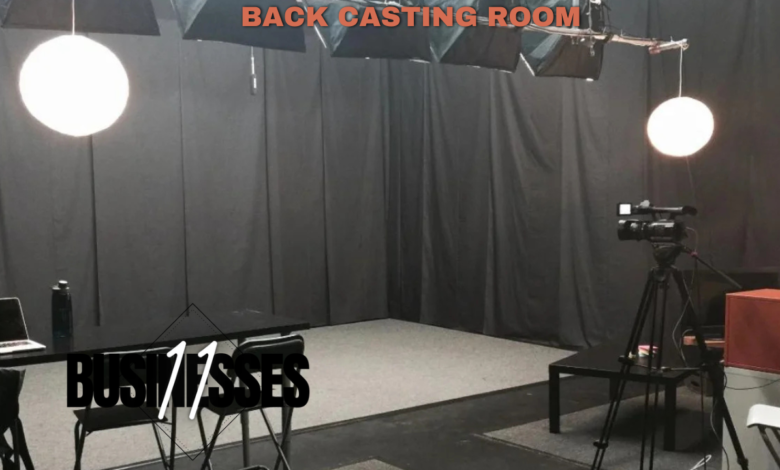Back Casting Room: Understanding Its Purpose and Process

The It is a unique space used in various industries, from filmmaking to manufacturing. In this room, a specialized process is carried out where objects are molded or cast, typically from models or prototypes, to produce accurate replicas.
Back casting is often used to create tools, parts, or artistic sculptures.
But what exactly happens in a back casting room? Let’s break it down and understand its purpose, benefits, and how it fits into larger production systems.
What Happens in a Back Casting Room?
A back casting room is where the process of casting takes place. In simple terms, casting is when liquid material, like metal or plastic, is poured into a mold and allowed to harden into a specific shape.
The “back” in back casting usually refers to casting that is done after an initial model or prototype is created. This can be useful for making multiple copies of an object or for creating parts that need to fit perfectly together.
In the back casting room, precision is key. Molds are created to exact specifications, ensuring that the final product is accurate.
Workers use specialized equipment to handle the materials, whether it’s molten metal, plastic resin, or other casting substances. Once the material cools and hardens, the mold is removed, revealing the cast object.
Why Is a Back Casting Room Necessary?
The It serves a vital role in industries where precision and accuracy are important. By having a dedicated space for casting, companies can ensure that the process is carried out in a controlled environment.
This room is designed to keep dust, moisture, and other contaminants away from the casting process, which can affect the quality of the final product.
This room allows for repeated production without compromising the quality of each cast. It’s not just about making one perfect object but ensuring that every object made is the same.
This consistency is important in industries like automotive manufacturing, aerospace, and even art creation.
How Does the Casting Process Work?
The casting process starts with a model, often referred to as a pattern, which represents the final object.
This model is placed into a mold made of a flexible material such as silicone or rubber. The mold is then used to create the cast object.
Once the mold is made, the liquid material is poured into it. In a It, temperature control is critical, as different materials need to be heated or cooled to specific temperatures.
After the material hardens, the mold is carefully removed. The object is then cleaned, polished, and, if necessary, painted or coated.
In many cases, the object is used as a final product or as a part in a larger system. The casting process in the It is detailed and precise, requiring skill and knowledge to get it right.
What Industries Use a It?
Many industries use Its, each for different purposes. In the film industry, Its are often used to create props, masks, or set pieces. These items need to be exact replicas to maintain continuity throughout the production.
In manufacturing, Its are used to create parts for machinery, tools, or vehicles. Each part must meet strict guidelines to ensure safety and functionality.
Even in medicine, Its are sometimes used to create prosthetic devices, which need to be custom-fitted to each patient.
Artists also use Its to create sculptures or replicas of their work. This allows them to produce multiple copies of a piece while maintaining its original detail.
The It is essential for any industry that values precision, accuracy, and repeatability.
Benefits of Using It
| Pros | Cons |
| Ensures high precision and accuracy | Requires specialized equipment |
| Enables mass production of parts | Can be expensive to set up |
| Reduces risk of contamination | Needs skilled workers |
| Offers controlled environment | Takes time to perfect each cast |
| Produces consistent results | Maintenance of tools and equipment |
A It offers many benefits, including a controlled environment that ensures the quality of each cast.
The process allows for the mass production of parts or objects while maintaining consistency. However, setting up a It can be expensive and requires specialized equipment and skilled workers.
Despite these challenges, the benefits of using a It make it a valuable asset in many industries.
What Materials Are Used in Back Casting?
Different materials can be used in a It, depending on the desired outcome. Common materials include metals like aluminum or steel, plastics, resins, and sometimes even ceramics. Each material has its own properties, making it suitable for different uses.
For example, metals are strong and durable, making them ideal for parts that need to withstand high stress or temperature.
Plastics and resins, on the other hand, are lighter and can be used in products that don’t require as much strength.
The choice of material depends on what the final product is and how it will be used. Workers in a It need to know the properties of each material to ensure the best results.
How Are Molds Made in a It?
Molds are an essential part of the casting process. In a It, molds can be made from a variety of materials, but silicone and rubber are the most common.
These materials are flexible, making it easier to remove the cast object without damaging it. The mold is created by pouring the flexible material around the model and allowing it to harden.
Once the mold is ready, it can be used repeatedly to create identical objects. Molds need to be well-maintained and cleaned to prevent contamination or damage, which can affect the quality of the cast object.
In some cases, molds are even reinforced with metal or other materials to make them more durable.
What Challenges Are Faced in a It?
Working in a It can be challenging. One of the main challenges is controlling the environment. Temperature and humidity can affect how materials behave, so workers need to carefully monitor these factors.
Another challenge is ensuring that the molds are free from defects. Even a small imperfection in the mold can result in a flawed product.
Skilled workers are needed to operate the machinery and handle the materials in a It. These workers need to be trained to spot potential problems and know how to fix them.
Although the process can be complex, with the right knowledge and tools, these challenges can be overcome to produce high-quality cast objects.
How Can You Improve the Efficiency of a It?
Improving efficiency in a It is all about optimizing the process. This can involve using better materials for molds, improving temperature control, or automating parts of the process.
One way to improve efficiency is by using high-quality materials that don’t break down as quickly, reducing the need for mold replacements.
Automation can also play a role in speeding up production. Machines can be used to pour materials more accurately, ensuring that each cast is identical.
By improving efficiency, the back casting room can produce more objects in less time without sacrificing quality.
What Are the Future Trends for Back Casting Rooms?
As technology advances, back casting rooms are also evolving. New materials, like 3D-printed molds, are being used to create even more precise casts.
Automation is also becoming more common, with robots being used to handle materials and molds. This reduces the need for manual labor and can help improve both speed and consistency.
The future of the It looks promising, with technology helping to improve efficiency, precision, and sustainability. While the basic process of casting may remain the same, the tools and materials used will continue to evolve.
FAQs About Back Casting Room
What is a back casting room?
A back casting room is a specialized space where the process of casting takes place. It’s typically used in industries like manufacturing, film production, and art to create objects, parts, or replicas from molds.
The room is designed to control environmental factors, ensuring that the casting process is accurate and consistent.
What happens in a back casting room?
In a back casting room, a liquid material such as metal, plastic, or resin is poured into a mold. Once it hardens, the mold is removed, revealing a cast object. This process allows for the creation of precise replicas of models or prototypes.
Why is a back casting room necessary?
The room provides a controlled environment free from contaminants like dust and moisture, which can impact the quality of the cast. It also allows for the mass production of parts or objects while maintaining consistency in each piece.
What industries use back casting rooms?
Back casting rooms are used in a variety of industries, including automotive, aerospace, film production, medical prosthetics, and art. Any industry that requires precise replicas or parts uses this space.
What materials are used in a back casting room?
Common materials used in back casting rooms include metals (such as aluminum or steel), plastics, resins, and ceramics. The choice of material depends on the product being created and its intended use.
What are the benefits of using a back casting room?
The main benefits include precision, mass production capabilities, consistency in quality, and a clean environment that reduces the risk of defects in the cast objects. It also allows for the efficient creation of multiple copies from one mold.
What challenges do workers face in a back casting room?
Workers must carefully control temperature and humidity to ensure that materials behave as expected. They also need to ensure that molds are free of defects and that the process is carried out with precision. Skilled labor and specialized equipment are essential in overcoming these challenges.
Can molds be reused in a back casting room?
Yes, molds are typically reusable, allowing for the creation of multiple objects from a single mold. However, the mold must be maintained properly to avoid defects in the cast objects.
How does automation impact back casting rooms?
Automation improves efficiency by speeding up production and reducing manual labor. Machines can accurately pour materials and handle molds, leading to faster production times while maintaining quality and precision.
What is the future of back casting rooms?
The future of back casting rooms includes advancements in technology such as 3D-printed molds and increased automation.
These developments are improving precision, efficiency, and environmental sustainability, making the back casting room even more valuable in various industries.
Conclusion
The back casting room plays a critical role in many industries. From making movie props to manufacturing car parts, the work done in this room ensures that objects are made accurately and consistently.
With advances in technology, the process is becoming even more efficient, making the back casting room a vital part of production for years to come.





